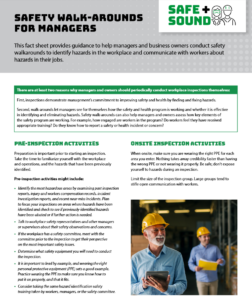 OSHA is promoting its SAFE + SOUND Campaign by highlighting two primary reasons why managers and owners should periodically conduct workplace safety walk-arounds (inspections):
OSHA is promoting its SAFE + SOUND Campaign by highlighting two primary reasons why managers and owners should periodically conduct workplace safety walk-arounds (inspections):
- Walk-arounds demonstrate management’s commitment to improving safety and health by finding and fixing hazards.
- Walk-arounds let managers see for themselves how their safety and health program is working and whether it is effective in identifying and eliminating hazards.
A walk-around workplace inspection can help you determine how engaged your workers are in the program, whether workers feel they have received appropriate training and whether they know how to report a safety or health incident or concern.
OSHA has created a SAFETY WALK-AROUNDS FOR MANAGERS fact sheet to provide guidance to help managers and business owners conduct safety walkarounds to identify hazards in the workplace and communicate with workers about hazards in their jobs. The fact sheet organizes a walk-around into:
Pre-Inspection
It’s important to take the time to familiarize yourself with the workplace, the operations and any hazards that have been previously identified.
Onsite Inspection/Walk-Around
Suggestions for an effective walk-around include:
- Look for easily observable hazards first, such as blocked exits, frayed/exposed electrical wires, missing machine guards and poorly maintained equipment.
- Talk to workers at their workstations and assure them that you are interested in finding and fixing problems, improving safety and not blaming anyone for your findings.
- Make a list of hazards that need to be addressed and prioritize them according to the severity of the potential injuries that might occur as a result of workers being exposed to the hazards.
Post-Inspection
Follow-up is important to establishing your credibility as a manager who is committed to improving safety. Suggestions include:
- Prepare an abatement plan containing a list of the hazards found, corrective actions needed, and a reasonable timeline for implementation.
- Describe briefly how the hazards will be addressed and identify interim controls that will be used while more permanent measures are developed.
- Share the abatement plan with managers, supervisors and workers as a way of showing your commitment to fixing the safety issues found during your inspection.
- Track progress by sharing or posting periodic updates to the plan.
